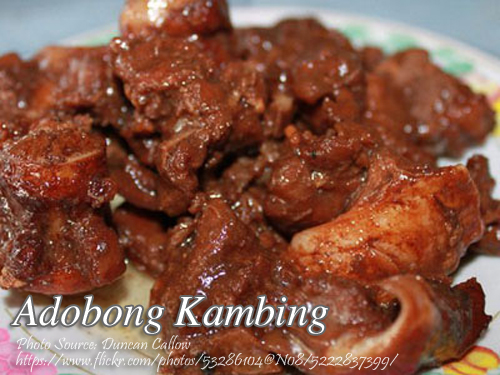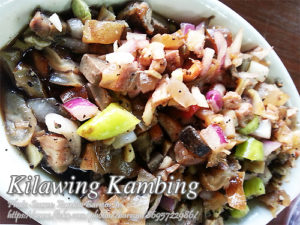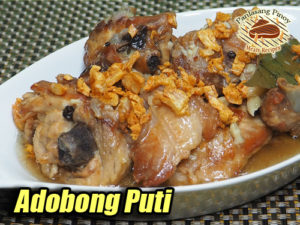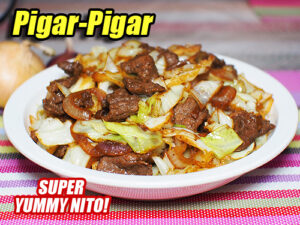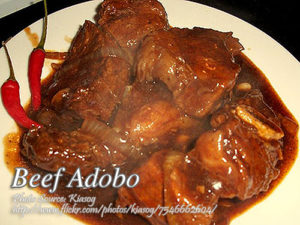Adobo dish usually use pork or chicken and maybe because those meat are readily available compared to beef or goat meat (and more expensive too). The only disadvantage on cooking goat meat specially in an adobo dish is the odor. So there are some extra procedure on cooking adobong kambing.
A Family Tradition with a Special Twist
Growing up in the province, goat meat wasn’t something we had every day. It was reserved for special occasions, a treat we’d only enjoy when my uncle came back from one of his long trips to the farm. He always brought back fresh cuts of goat, ready to be turned into delicious dishes that filled our kitchen with an unforgettable aroma. One of the dishes he swore by was this version of adobo, one that was a little more labor-intensive but absolutely worth it.
Goat meat is a bit more delicate to handle than pork or chicken, which are more commonly used in adobo. The challenge with goat lies in its strong, gamey flavor, something that can be off-putting if not cooked the right way. My uncle always insisted that the secret to mastering this dish was all in the preparation, specifically when dealing with that infamous odor. He used to say, “The flavor’s all there, you just need to coax it out.”
Preparing Goat Meat for the Perfect Adobo
One of the first things my family taught me about cooking this type of adobo was to never skip the boiling step. As kids, we’d gather in the kitchen, peeking over the counter, watching my uncle toss ginger into a pot of boiling water along with the goat meat. This wasn’t just any step — it was crucial for taming the strong, distinct odor of goat meat. You’d think ginger was magic by the way it worked to neutralize that gamey scent, leaving behind meat that was perfect for frying and stewing.
After boiling, the meat wasn’t yet done. My uncle had a love for anything fried, and he firmly believed that frying the meat first would lock in all the goodness before it was simmered in the rich adobo sauce. Once the goat meat was out of the pot, it would take a quick dip into hot oil, giving it a nice, crispy exterior. This not only added texture but a deep layer of flavor that would stand up to the soy-vinegar mixture later on.
Simmering the Meat in the Rich Adobo Sauce
I can still remember the sizzle of garlic as it hit the hot oil, the start of our favorite part: making the sauce. Soy sauce, vinegar, and a touch of water formed the base, but what made it truly special were the aromatics. Laurel leaves and cracked black pepper would join the mix, infusing the sauce with layers of savory goodness.
When the fried goat meat was added back into this rich broth, the house would be filled with the unmistakable scent of a true Filipino adobo. But we weren’t done just yet. After simmering for a while, the meat had to be removed again — this was a trick my uncle taught me to ensure the sauce would thicken just right. A few more minutes in the pan with garlic, onions, and chili peppers, and we’d have a dish that was not only tender but had a thick, flavorful sauce clinging to every piece of meat.
A Special Dish with a Special History
There’s something deeply nostalgic about cooking this dish, as it always brings me back to those days in my childhood home. I later found out that this goat adobo has roots in many regions of the Philippines where goat farming is common. It’s a dish that’s been passed down through generations, often reserved for feasts or special gatherings. Goat, after all, is a more expensive and less accessible meat compared to pork or chicken, making this adobo a rare treat for many.
Historically, adobo has always been a dish of preservation. Before refrigerators were common in Filipino households, our ancestors used vinegar and salt as natural preservatives, and adobo was a method that made use of both. Though times have changed, the use of vinegar in the dish remains, now more for flavor than necessity. It’s a reminder of how simple, humble ingredients have the power to transform any dish into something that feels luxurious and rich in history.
Making the Dish Your Own
What I love about this version of adobo is how customizable it can be. If you’re someone who loves a bit of heat, you can add more chili peppers for a spicier kick. My sister, who recently moved back from Bicol, loves to throw in more spices and coconut milk, a twist she picked up during her time there. On the other hand, my brother, who spent a few years in Ilocos, insists on using sugarcane vinegar for a slightly sweeter finish.
The key to mastering this dish is patience. Goat meat can be tough if not cooked properly, but with the right steps, you’ll end up with tender, flavorful meat that’s infused with all the savory goodness of soy sauce and garlic. And if you’ve followed my uncle’s advice to a T, you’ll even forget that goat meat ever had that strong smell to begin with.
A Delicious Tradition Worth Trying
If you’ve never tried making goat adobo before, this is your sign to give it a go. Yes, it might require a bit more attention than your usual chicken or pork version, but the results are undeniably worth it. And the best part? You’ll have a dish that not only tastes incredible but comes with a story, one that speaks of family traditions, regional specialties, and the beautiful simplicity of Filipino cuisine.
So the next time you’re craving adobo, why not try it with goat? You might just find yourself making it more often than you’d expect.
How to Cook Adobong Kambing (Goat Meat Adobo)
Ingredients
- 1 kilo goat meat
- 1 pc ginger (2 inch) slivered
- 1/2 head garlic shredded
- 2 pcs onion chopped
- 5 pcs red chili pepper siling labuyo
- 2 pcs. laurel leaves
- 1 tsp. whole peppercorn
- 1 cup soy sauce
- 1 cup vinegar
- 1/2 cup water
- cooking oil
Instructions
How to cook adobong kambing:
- Boil the goat meat with ginger to remove the goat odor.
- Then cook the goat meat until tender but not too much because it will be fried later.
- Remove the meat from the pot and deep fry for 10 minutes. Darin and transfer the meat on a bowl and set aside.
- In an empty pot, put soy sauce, vinegar, water, pepper and shredded garlic and simmer with the fried goat meat until tender. Remove the goat meat again and place in a bowl. Set aside the soy sauce, vinegar and garlic mixture where you cooked the goat meat.
- In a pan saute garlic and put the goat meat and stir-fry for a few minutes then pour a little bit of the soy sauce, vinegar and garlic mixture.
- Add the shredded chili peppers and onion, laurel leaves and simmer until the liquid has evaporated and the sauce becomes very thick.
Notes
Cooking Tips:
Control the Odor with Ginger
To eliminate the strong, gamey smell of goat meat, always boil it with ginger. This helps neutralize the odor and leaves the meat ready to absorb the savory flavors of the sauce. Skipping this step might result in a dish with a stronger smell that can overpower the other ingredients.Fry the Meat for Extra Texture
Frying the goat meat after boiling adds a delightful crispiness to the exterior while keeping the inside tender. This step locks in the flavors and gives the dish a richer texture. It also helps the meat hold up during the final simmer in the sauce, preventing it from becoming too soft.Simmer to Achieve a Thick, Flavorful Sauce
Simmering the goat meat in the soy sauce and vinegar mixture is key to developing deep, rich flavors. Let the liquid reduce slowly until it forms a thick sauce that clings to each piece of meat. This step ensures the meat fully absorbs the flavors while keeping the sauce rich and concentrated.
